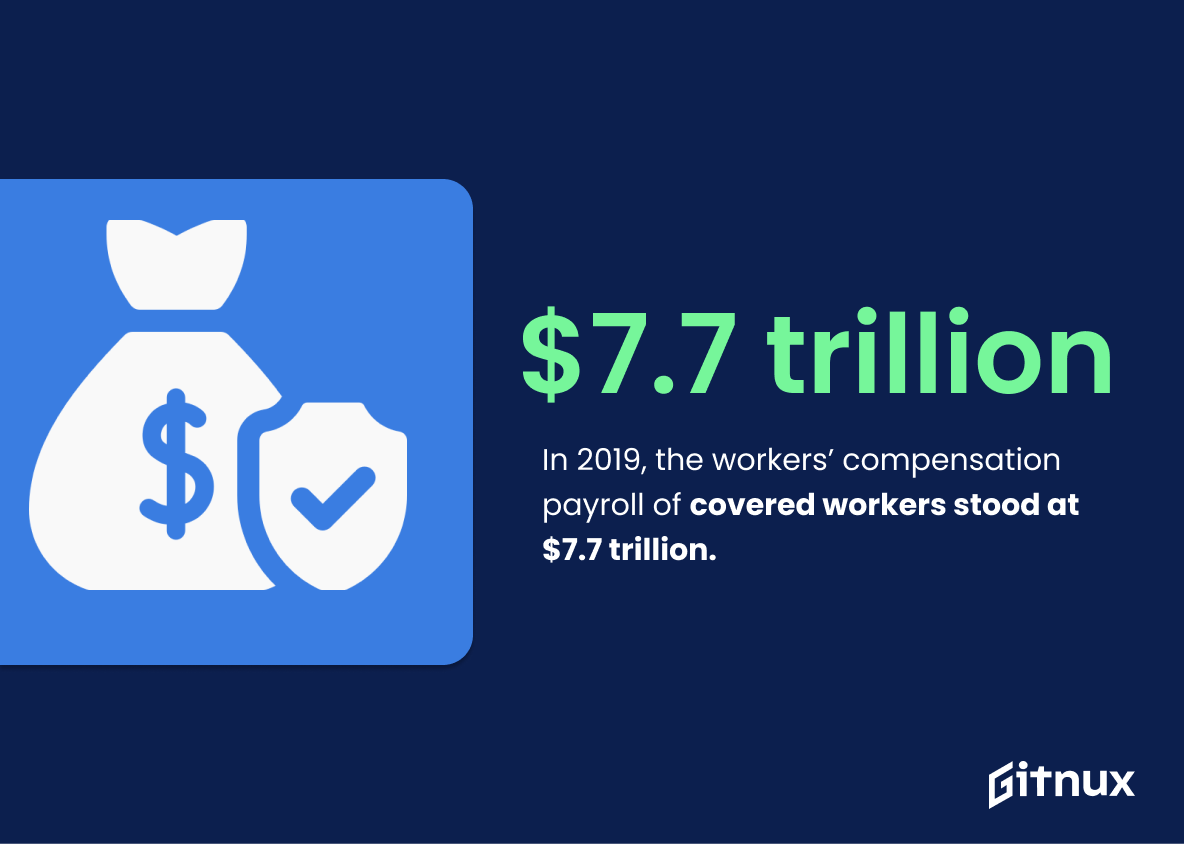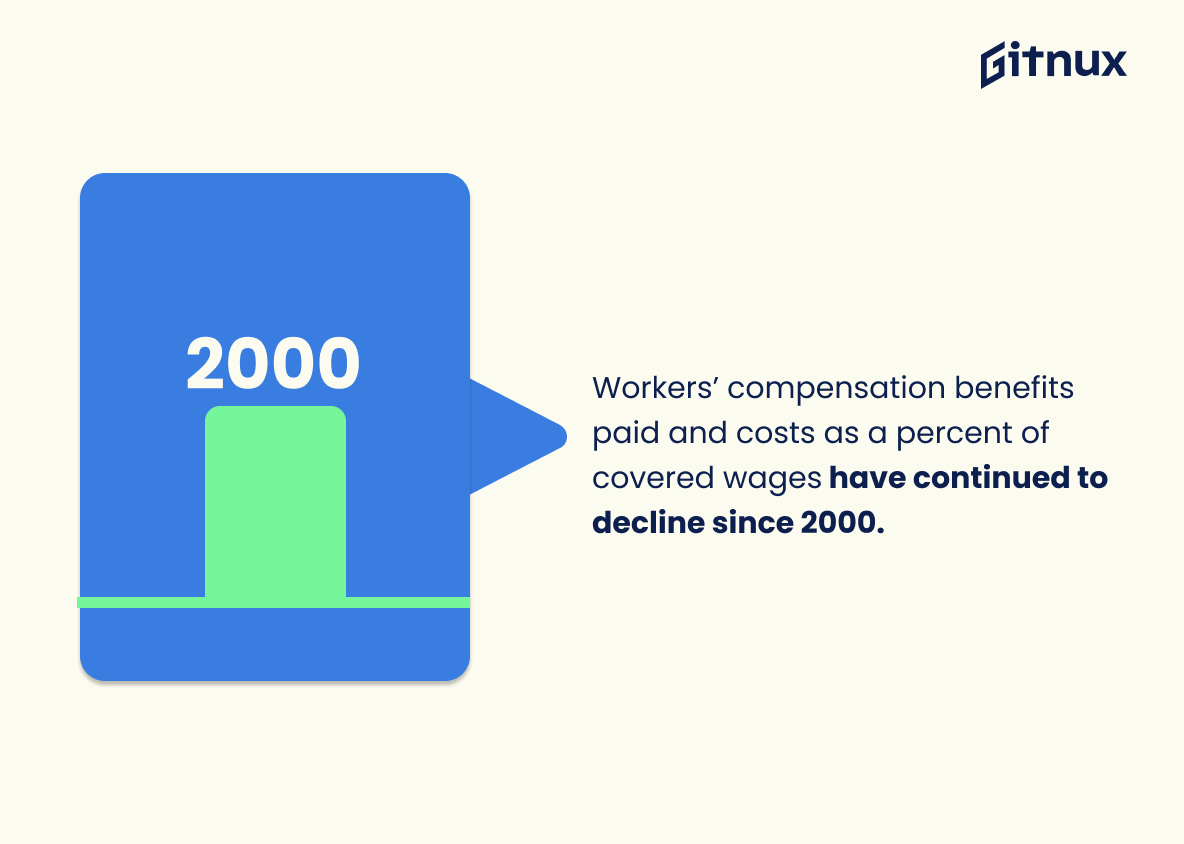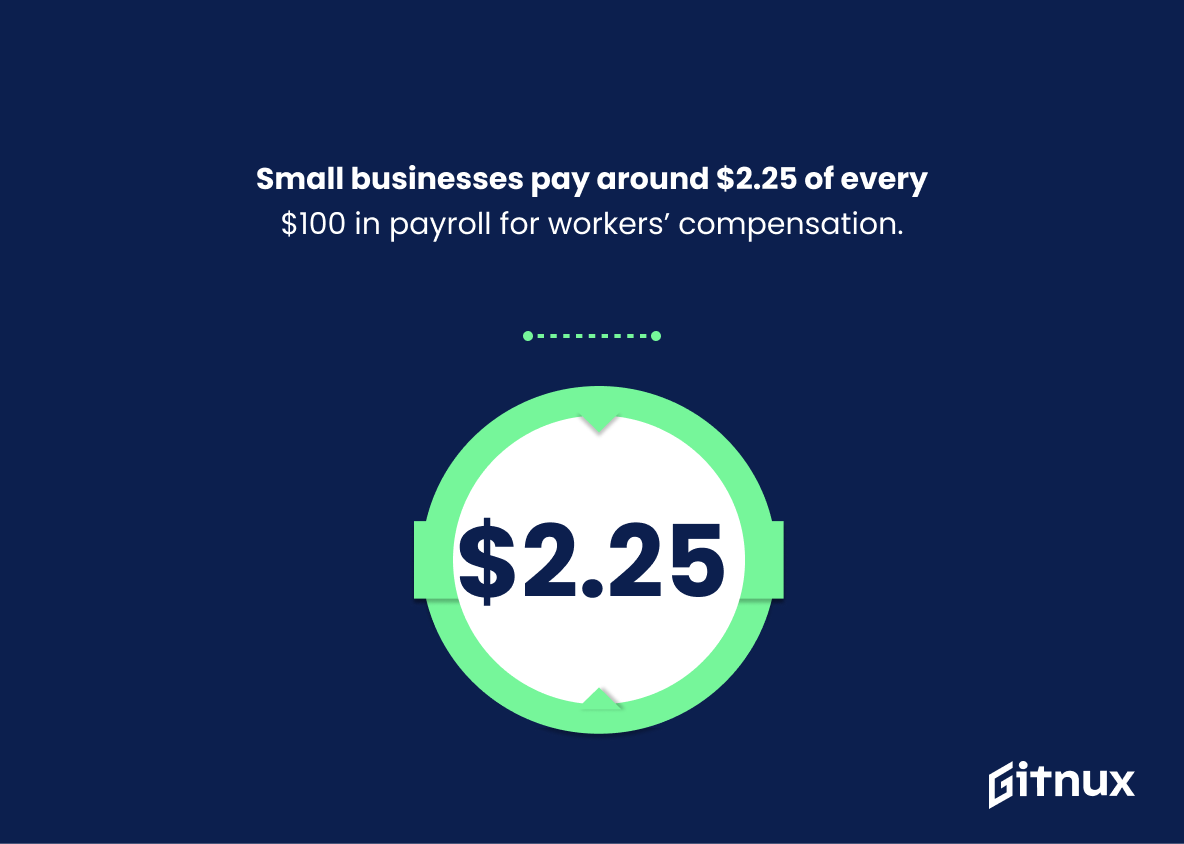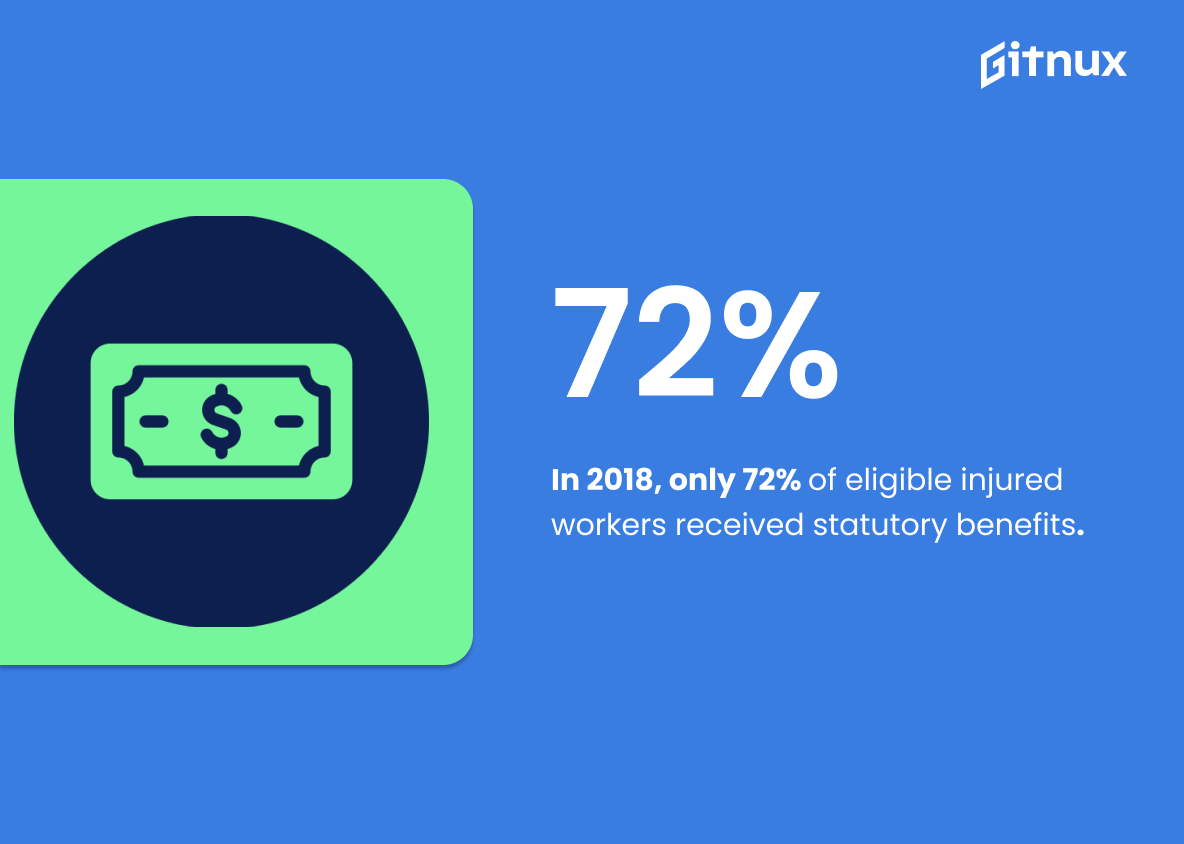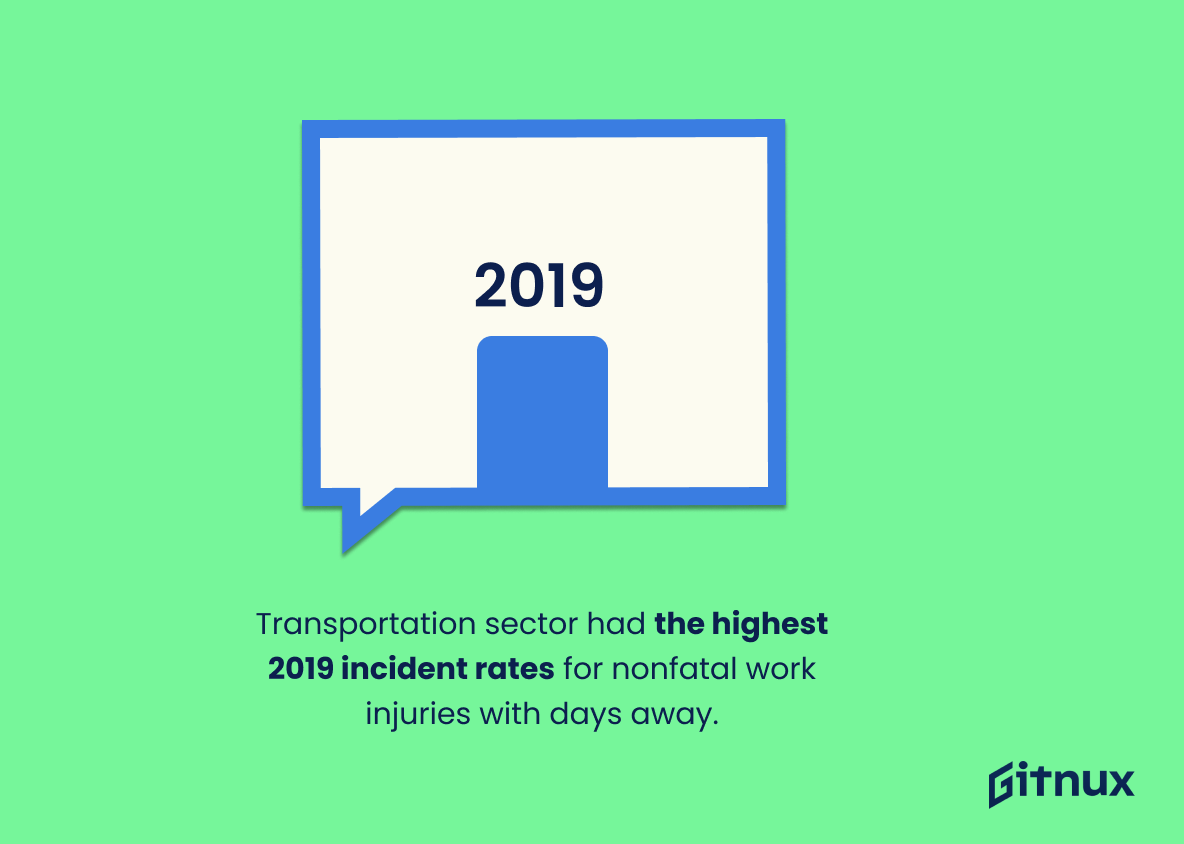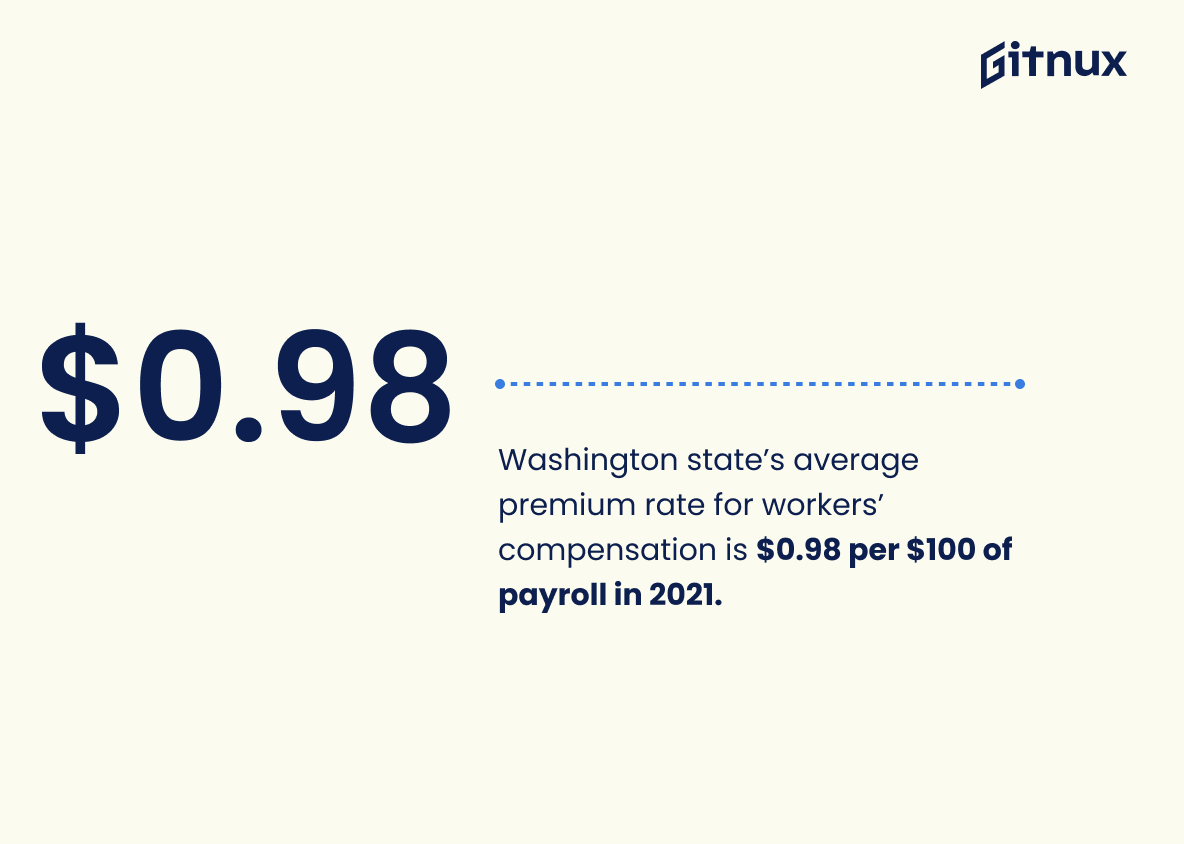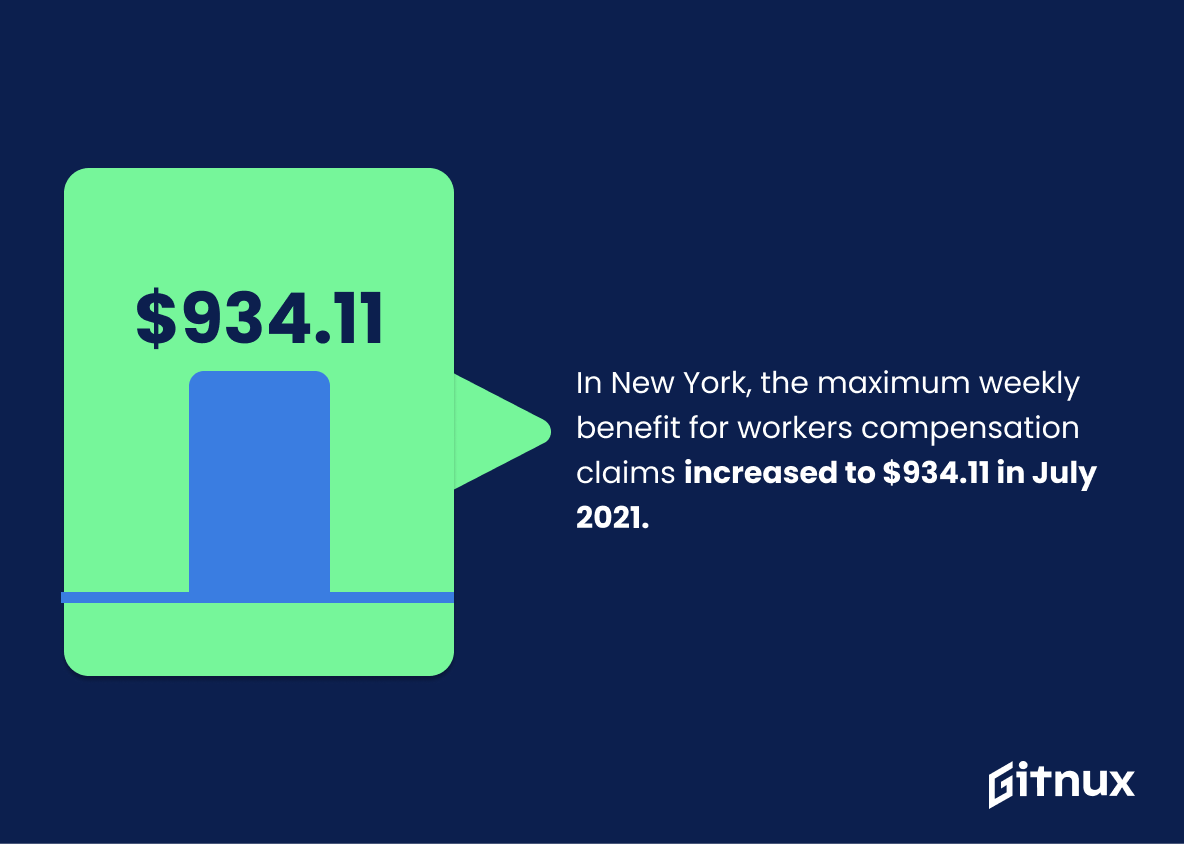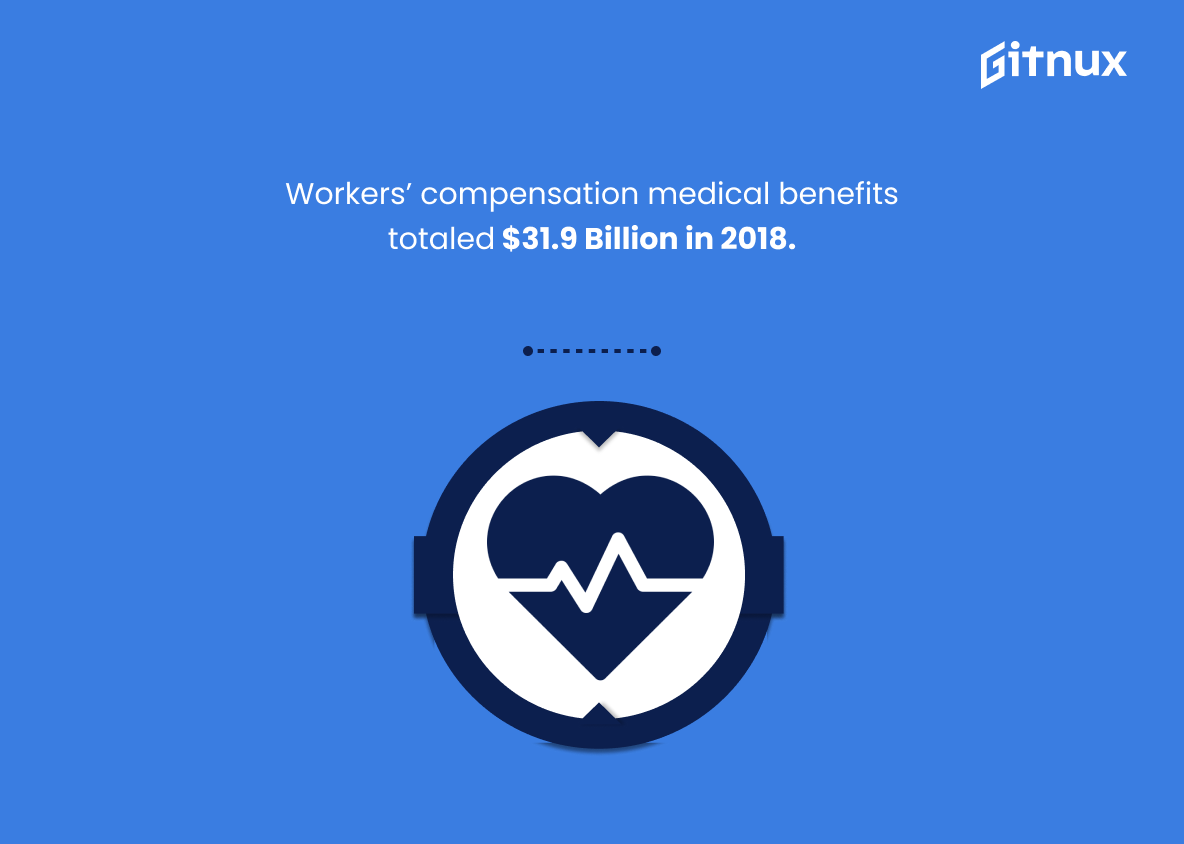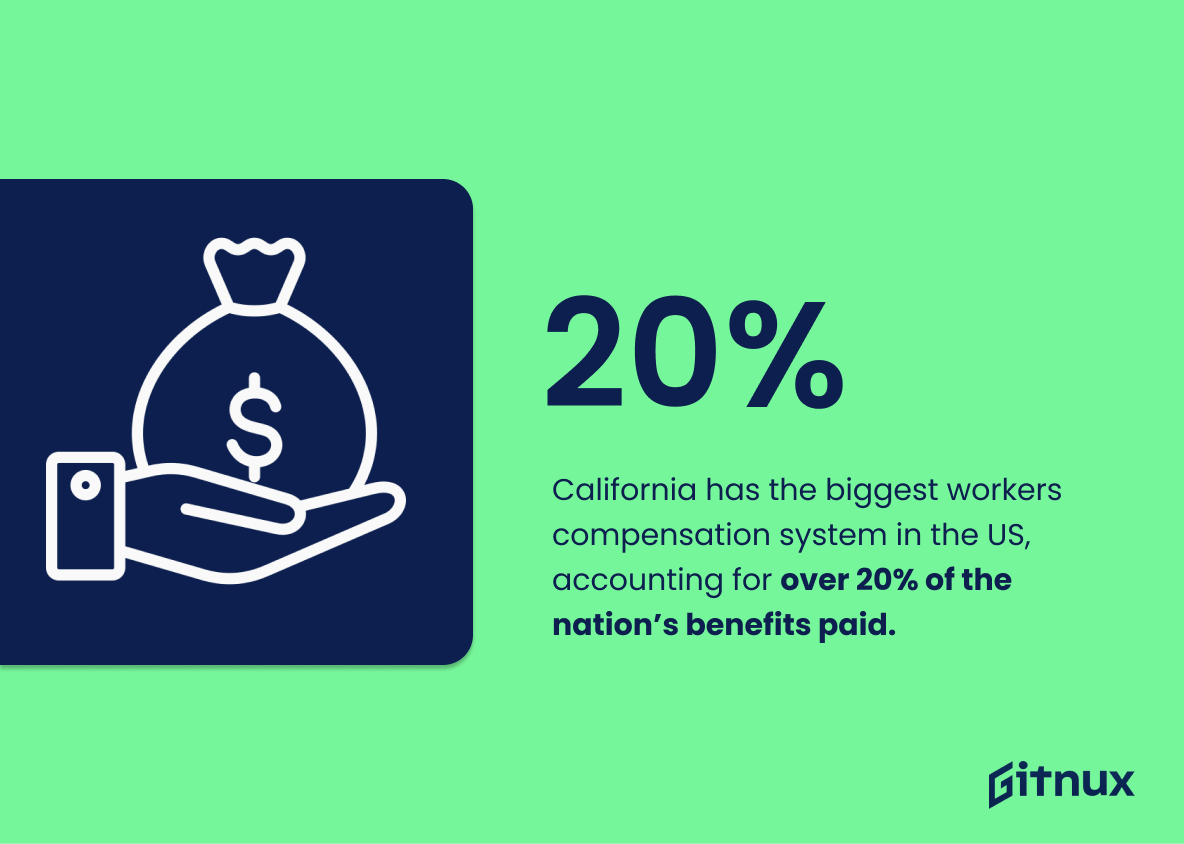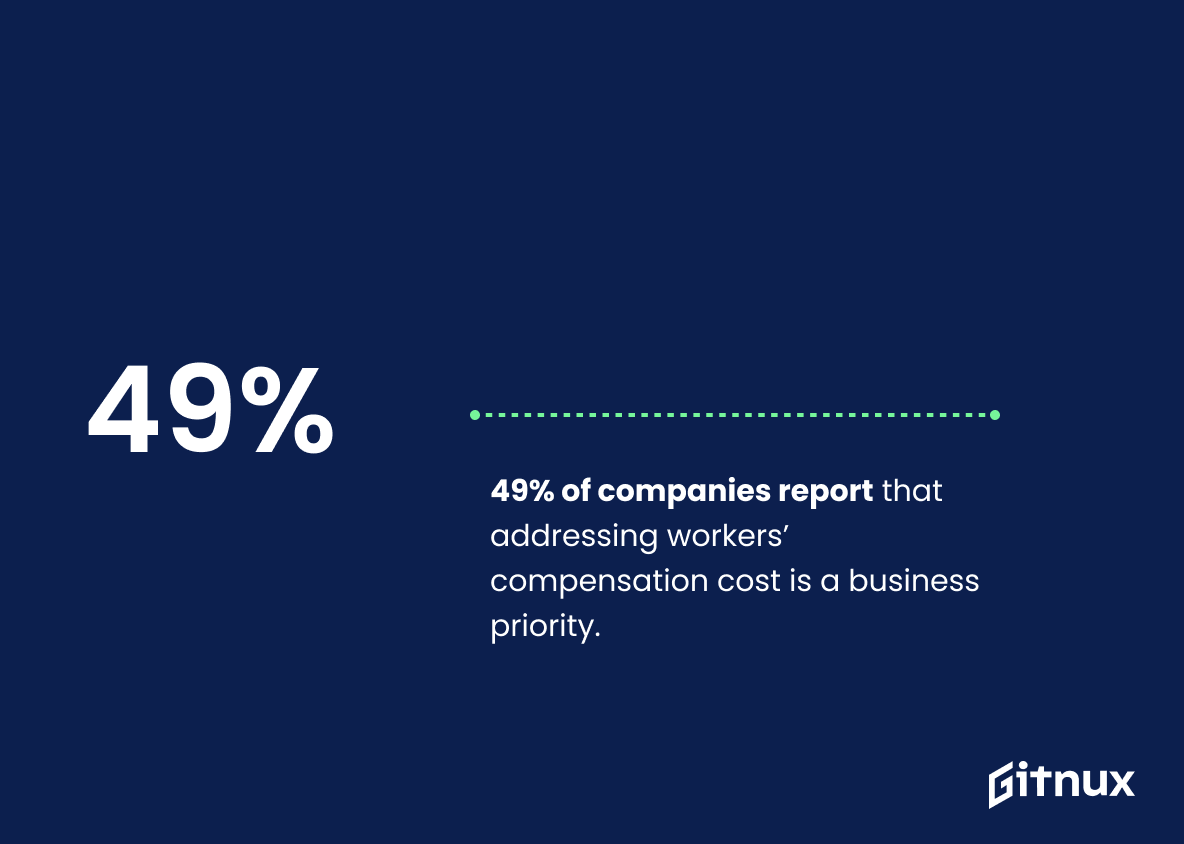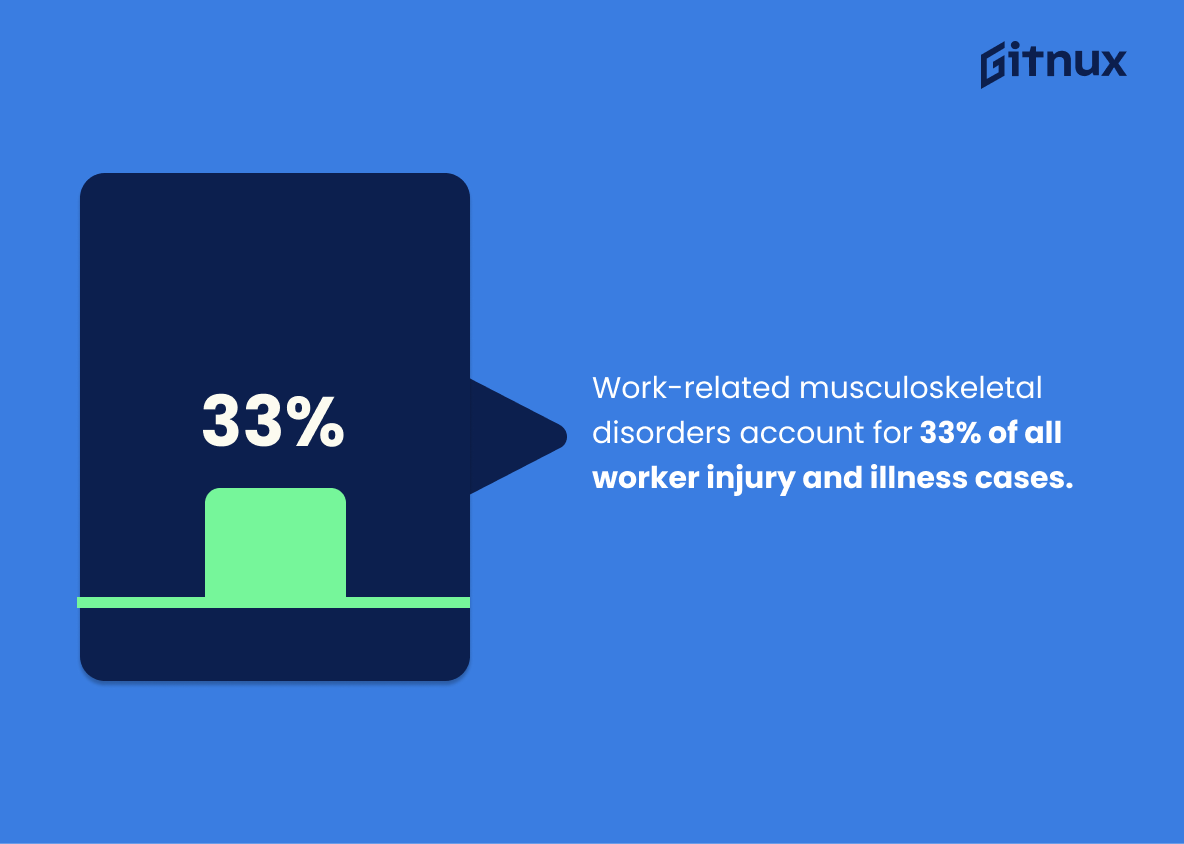Keeping a keen eye on workers’ compensation statistics is an integral part of navigating the complex landscape of workplace safety and finances. It’s an ever-evolving field, with data that paints a compelling picture – revealing trends, patterns, and potential issues that may affect employers and employees alike. Whether you’re a small business owner, a human resources professional, or a worker concerned about your rights, understanding these statistics can offer invaluable insights. In this blog post, we delve into the most significant workers’ compensation statistics, breaking down their implications and paving the way for a more informed, proactive approach to workplace safety and compensation.
The Latest Workers Compensation Statistics Unveiled
In 2019, the workers’ compensation payroll of covered workers stood at $7.7 trillion.
Displaying the monumental figure of $7.7 trillion as the workers’ compensation payroll for covered workers in 2019 amplifies the broad impact and role of workers’ compensation in our economy. It underscores the sheer volume of financial protection employers are providing for their workers. Encapsulated in this staggering sum is the ability of countless employees to find financial stability despite work-related injuries or illnesses. Therefore, in a blog post about Workers Compensation Statistics, it’s a pivotal point, painting a compelling big picture of workers’ compensation’s importance in rugged landscapes of labor and industry. It sets the stage for understanding the massive scale at which employers are shielding their workforce from financial hardship resulting from work-related mishaps. It certainly makes the readers sit up and take notice of the issue at hand.
In 2018, 2.8 million nonfatal workplace injuries and illnesses were reported in the United States.
In the realm of Workers Compensation Statistics, the revelation that 2.8 million nonfatal workplace injuries and illnesses were reported in the United States in 2018 is of striking significance. Not only does this daunting figure underscore the sheer magnitude of health and safety risks posing workers across various industries, but it also speaks volumes about the critical nature of workers’ compensation schemes for both employees and employers alike. It provides a tangible perspective on the vast number of individuals who may need to utilize workers’ compensation and triggers introspection into whether current policies are adequately offering the protection they are designed for. Likewise, it might act as a vivid reminder for businesses to prioritize workplace safety in order to minimize injuries and illnesses, thereby reducing the need for such compensations.
Approximately 5,333 workers died from a work injury in the U.S. in 2019.
Underscoring the critical nature of employee insurance, a sobering revelation emerges from the data from 2019. In that year alone, an alarming number of 5,333 souls were lost due to work-related injuries in the U.S., painting a vivid picture of the potential danger lurking in our workplaces. This figure, stark and eye-opening, reinforces the relevance of workers’ compensation programs, drawing attention to their indispensable role in safeguarding individuals from the financial wreckage that workplace accidents often entail.
Workers’ compensation benefits paid and costs as a percent of covered wages have continued to decline since 2000.
Highlighting the trend of a continuous decline in workers’ compensation benefits and costs as a percent of covered wages since 2000, uncovers a crucial narrative in the workers compensation landscape. This proffers a perspective on the changing economic conditions and corporate policies that impact the lives of workers, particularly those susceptible to workplace injuries. Contemplating on these figures, we potentially unveil astonishing aspects like the efficiency of the workers compensation system or the potential neglect of worker rights. This offers invaluable insights to policy makers, employers, unions and the workers themselves, helping them to comprehend and navigate the dynamic terrain of labour economics and compensation policies.
Small businesses pay around $2.25 of every $100 in payroll for workers’ compensation.
“Peering into the landscape of workers’ compensation, we find a gem that unveils a powerful reality about small businesses. Picture this – with every crisp $100 note exchanged in payroll, a little over two dollars is channeled towards workers’ compensation. These real dollars represent not just a cost of doing business, but an investment into the safety net of the workforce, cushioning them in the face of adversity. It is part of the life-blood that keeps the gears of business turning smoothly, translating into employee confidence and productivity. Hence, this figure is not just a statistic, but a small yet poignant chapter in the story of labor strength and security.”
In 2018, only 72% of eligible injured workers received statutory benefits.
Drawing attention to the fact that in 2018, only 72% of eligible injured workers received statutory benefits underlines the gravity of gaps existing within the Workers Compensation system. It emphasizes the crucial need for comprehensive reforms and stricter enforcement of policies. The purpose of sharing this finding is not just to bring awareness to an under-discussed issue, but also to bolster the argument that clear improvements must be made. This data can serve to instigate necessary dialogue and potentially transformative change, ensuring a fairer and more balanced system that better supports the needs of injured workers. It highlights an alarming reality in stark numerical terms; a rallying point that may engage readers, evoke empathy, and inspire action.
Transportation and warehousing sector have the highest incident rates for nonfatal occupational injuries and illnesses involving days away from work in 2019.
In the intricate world of Workers Compensation Statistics, the nugget of data revealing the Transportation and Warehousing sector’s incident lead for nonfatal occupational injuries and illnesses gives us a fascinating perspective. It presents us with a spotlight on a particular area of concern for businesses, insurers, and of course, the employees themselves. It’s akin to a road map, guiding us towards the lay of the land where there’s an obvious plea for attention in reducing workplace incidents.
Passing this bridge, we can further deduce that for those days when unfortunate work-related injuries do occur, employees are left no other choice but to take an unwelcome leave from work. This has ripple effects on the business’s productivity, the worker’s morale, their family’s income stability and even impacts the dynamics of the workplace safety programs.
The sentence encapsulates a reality where regulators, insurers, trade unions and businesses have to double their efforts. They must collaborate to develop safer working environments, reinforced by robust occupational safety guidelines. Furthermore, this compelling statistic raises the flag for insurance companies who are deeply entrenched in the workers compensation game. It subtly nudges them to reassess their risk pricing models, broadening their understanding of where the landmines are predominantly located. So, this solitary fact offers multiple pathways of exploration, each of monumental significance in the world of workers’ compensation, bringing several hidden aspects of it into sharp focus.
Washington state’s average premium rate for workers’ compensation is $0.98 per $100 of payroll in 2021.
Diving into the intricacies of Workers Compensation Statistics, the metric illustrating that Washington State’s average premium rate for workers’ compensation is $0.98 per $100 of payroll in 2021, weaves its own insightful narrative. This figure sets the stage, painting a clear picture of both the burden carried by employers and the safety net available for employees across the evergreen state. By contemplating this rate, readers can gain a unique understanding of how Washington handles business expenses and employee protection relative to other regions, thereby serving as a vital compass to navigate the broader landscape of workers’ compensation.
In New York, the maximum weekly benefit for workers compensation claims increased to $934.11 in July 2021.
The surge to $934.11 in the maximum weekly benefit for workers compensation claims in New York as of July 2021 furnishes an illuminating prism through which the landscape of Workers Compensation claims can be examined. This critical milestone does not only portray the empathy and commitment of the state to support the injured or ill workers, it also sheds light upon evolving trends in both policy and economy. It signifies an upward adjustment, spotlighting the continuous efforts to remain abreast with cost of living adjustments, inflation, and the overall quality of life. This evaluation serves as an indispensable waypoint for observers globally, setting the bar for what compensations and workers infrastructures could aspire to achieve. Also, it draws a clear picture of the real-world impact of such policies, giving stakeholders, from companies to employees, a tangible measure of what support is available amidst work-induced adversities. Thus, this statistic in effect, becomes a pulsating heart within the body of any discussion on Workers Compensation.
Workers’ compensation medical benefits totaled $31.9 Billion in 2018.
The robust sum of $31.9 billion in medical benefits for workers’ compensation in 2018 provides a potent testament to the economic impact of workplace injuries and illnesses. It not only underscores the financial liabilities businesses face when it comes to employee safety, but also reflects the costs borne by insurance companies in mitigating these occupational hazards. Revealing this statistic in a blog about Workers Compensation Statistics paints a vivid picture of the monetary magnitude involved, which is a critical component in comprehending the broader issues surrounding workers’ compensation, setting the stage for a deeper and more informed discussion.
California has the biggest workers compensation system in the US, accounting for over 20% of the nation’s benefits paid.
Highlighting that California holds a significant one-fifth of the nation’s workers compensation benefits payout underscores the magnitude and influence of the state’s system in the overall US framework. In the galaxy of workers compensation statistics, it’s a burning sun that illuminates how regulations, industrial composition, and state-level policies may impact workers’ compensation culture nationwide. More than just a data point, it’s a lens through which we can scrutinize and draw broader implications about workers’ rights, labor economics, and compensation trends.
Workers 55 and over accounted for 17% of nonfatal occupational injuries and illnesses involving days away from work in 2019.
Highlighting this statistic, where workers aged 55 and over account for 17% of nonfatal occupational injuries and illnesses necessitating absences in 2019, underscores a significant trend that might otherwise become an unnoticed factor in the broad landscape of Workers Compensation Statistics. It serves as a beacon, illuminating the important correlation between age and workplace-related injuries and illnesses — a subject requiring further attention from both employers and policymakers. This figure emphasizes the need for adaptive, age-appropriate work environments and protocols to reduce occupational injuries among older workers, and thereby potentially limit the financial strain on compensation systems. It is thus a vital component in understanding the intricate web of influences affecting Workers Compensation, ultimately guiding the development of safer, healthier work conditions for all age demographics.
49% of companies report that addressing workers’ compensation cost is a business priority.
Peeling back the layers of the statistic ‘49% of companies report that addressing workers’ compensation cost is a business priority,’ one can appreciate its profound relevance. With almost half of businesses prioritizing workers’ compensation costs, it becomes vividly clear that this isn’t a peripheral issue, but rather a glaring necessity that demands attention, underscoring the magnitude of the matter on a corporate level. In the context of a blog post about Workers Compensation Statistics, this statistic serves as a compelling testament to the widespread concern and the urgent need for systematic strategies to handle these costs efficiently. This not only has significant ramifications for businesses’ financial health but also for their reputation, worker satisfaction, and overall success.
Work-related musculoskeletal disorders account for 33% of all worker injury and illness cases.
Diving into workers’ compensation statistics, one intriguing figure stands out. It’s found that work-related muskeletal disorders make up 33% of all worker injury and illness cases. This isn’t just a number, it’s a massive chunk of the pie chart, a third of all the reasons a worker might be reduced to pain and suffering, stripped off their productivity and fighting for compensation.
This statistic invites us to reflect on the state of our workplaces and reconsider health and safety measures. It’s a call to action for employers to probe deeper into ergonomic solutions, alter work practices that put physical strain on workers and promote preventative health measures.
Moreover, it impacts economically as well. It’s a glaring indicator that along with the worker’s health, company resources are also being drained. As a whopping 33% of compensation claims are for musculoskeletal disorders, judicious steps taken towards workplace safety could, in theory, reduce compensation costs by a third.
Therefore, this statistic doesn’t just count people, but also recounts tales of pain borne by workers, the responsibility of employers and industries, and the potential for impactful change in workers’ health and safety. It’s a clear measure of priorities for policy makers, insurers and health and safety professionals, making it a key data point in any discussion around workers’ compensation statistics.
In 2020, South Dakota had the lowest workers’ compensation rates in the U.S.
Shedding light on the landscape of workers’ compensation across the U.S., the fact that South Dakota had the lowest rates in 2020 underlines a significant variance across different states. This pivotal data point anchors an understanding of regional disparities, contributing to a broader comprehension of workers’ compensation trends nationwide. It initiates a reflection on the different factors that play into these variations—be it due to distinctive labor laws, industry types, or employment conditions prevalent in different states. Furthermore, it might be a key consideration for businesses contemplating migration and for workers contemplating relocation.
Females make up 40% of nonfatal occupational injuries and illnesses involving days away from work in 2019.
Diving deep into the sea of Workers Compensation Statistics, one finds a glittering pearl of knowledge that gives a peculiar insight into the gender breakdown of workplace injuries and illnesses in 2019. Interestingly, 40% of nonfatal occupational injuries and illnesses requiring days off work involved females. At first glance, this ratio might seem unimpressive. However, take a moment to ponder.
Not only does this figure underscore the vital role employed women play in contributing to these statistics, but it also sheds light on the potential for greater risk-management strategies. By understanding this gender-based proportion, we can pave the way for more inclusive, gender-specific safety measures at workplaces. Thus, this number has strings attached to realms of workplace equality, ensuring health and safety, and understanding potential gender differences in job nature and responsibilities.
Furthermore, this figure also illuminates the pathway for creating a safer work environment for all individuals, irrespective of their gender, and more precisely, it grants us the ability to see past the stereotypical norms about labor-intensive jobs, equitably encompassing the efforts of all workers.
The average cost of a workers’ compensation claim for all types of claims is $40,051 in 2017/2018.
In the vast landscape of workers’ compensation statistics, the figure stating “The average cost of a workers’ compensation claim for all types of claims is $40,051 in 2017/2018.” stands as a towering peak. It offers readers a bird’s eye view of the financial implication associated with workers’ compensation claims. This numerical representation sets the scene for understanding the burden such claims have on businesses, insurance companies, and the economy at large. Furthermore, it judiciously highlights the potential financial impact the workers may bear in the absence of such compensation. By shedding light on this tangible cost, it underscores the importance of workers’ compensation from a fiscal perspective.
New claim frequency dropped by 11.6% in the first half of 2020 due to COVID-19 lockdowns affecting worksites.
Delving into the eye-opening revelation that new claim frequency sank by an arresting 11.6% in the debut half of 2020, it’s intriguing to note the influential role that COVID-19 lockdowns had in shaping this scenario. Within the vibrant canvas of Workers Compensation Statistics, this metric unfurls a distinctive narrative.
Breaking down the seeming monotony of charts and figures, this piece of information spotlights a direct correlation between workflow dynamics and the resultant claims, all thanks to COVID-induced lockdowns. This unearthly quiet on worksites unfolded an unmistakable downturn in claim frequency, a stark divergence from previous trends.
In the broader sense, this statistic adds another intriguing layer to understanding the multi-faceted impact of a pandemic on workers’ landscapes. It emphasizes how external factors, in this case, a global health crisis, can unexpectedly sway the ebb and flow of claims within the workers’ compensation universe.
Interpreting this remarkable downturn in claims during the lockdown, blog readers get a handle on the ever-evolving landscape of workplace safety and the potential monetary implications for businesses, insurance companies, and workers themselves. This statistic, thus serves as an essential data point in our collective comprehension of how seismic global events can reshape the very contours of workers’ compensation field.
Conclusion
In closing, the intricacies of Workers Compensation statistics reveal a vast and complex system dealing with workplace injuries and illnesses. These statistics are a crucial means for understanding the frequency, types, and costs of work-related injuries. They provide not only insights into the current state of workplace safety but also the challenges and efforts required to reduce occupational hazards and ensure employee safety. The pattern and trends identified in these statistics dramatically underscore the unceasing importance of efficient Workers Compensation programs. Businesses, policymakers, and safety professionals alike must continuously leverage these statistics to make informed decisions, shape robust safety standards, and ultimately, create safer work environments.
References
0. – https://www.www.ncci.com
1. – https://www.www.oregon.gov
2. – https://www.riskandinsurance.com
3. – https://www.www.ssa.gov
4. – https://www.www.osha.gov
5. – https://www.www.nasi.org
6. – https://www.lni.wa.gov
7. – https://www.www.bls.gov
8. – https://www.www.wcb.ny.gov
9. – https://www.www.insureon.com
10. – https://www.www.dir.ca.gov
11. – https://www.www.workcompcentral.com
